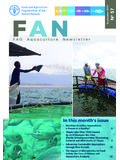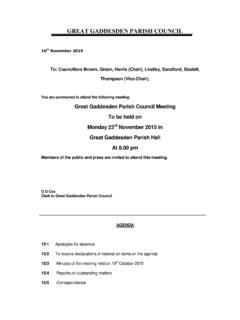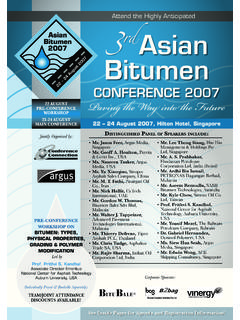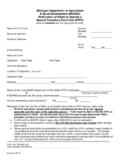Transcription of Women and Water - United Nations
1 United NATIONSD ivision for the Advancement of WomenDepartment of Economic and Social AffairsEdwina SandysFebruary 2005 PUBLISHED TO PROMOTE THE GOALS OF THE BEIJING DECLARATION AND THE PLATFORM FOR ACTIONW omenand WaterIntroductionWater and development: a growing crisisThere is widespread recognition that the world is facing a growing Water crisis, affecting the well-being of millions of the poorest people. Rapidly growing populations, urbani-zation, agricultural intensification and climate change (such as global warming) all contribute to greater competition and scarcity of Water resources. Despite massively increased provision of Water facilities over the past few decades and the development of low-cost, sustain-able technical solutions to many aspects of Water provision, millions still suffer from Water -related dis-eases and the physical, social and economic burdens associated with scarcity.
2 A number of international initiatives aim to tackle this global problem through improving the gov-ernance of Water and setting targets for provision of supplies to increased numbers of people within the general context of poverty alleviation and environmental sustainability. The greater involvement of Women and the adoption of gender-sensitive approaches are increasingly seen as integral to the achievement of these targets. In the context of the global concern for improved Water manage-ment (which encompasses sanita-tion and hygiene education), this paper aims to: Set out arguments for the impor-tance of a gender-sensitive approach to Water resources man-agement; Review progress in achieving this and draw out the lessons learned from experience; Identify some of the key challenges and opportunities to gender- equitable Water management; Suggest helpful resources for gender mainstreaming in Water resources is critical to the livelihoods and well-being of the world s popula-tion but millions suffer from lack of access to clean Water , inadequate Water for food production and the effects of pollution and environmental change.
3 Increasingly, improved Water supply management is seen as cen-trally important to poverty alleviation and to ensuring a sustainable future for millions of people with vulnerable livelihoods in marginal environments. The impact of inequitable access and poor management is huge. The United Nations reports billion people (one in six of the world s population) lack access to improved drinking Water , and billion lack sanitation. As a result, the burden of death and disease related to inadequate Water is high, with an estimated mortality of 3 mil-lion people a year, and millions more suffering Water -related diseases. The majority of those affected are likely to be children under five years old, affected by diarrhoeal is critical to food production. While the majority of agriculture is rain fed, irrigated agriculture provides some 40 per cent of the world s food and consumes 75 per cent of world s freshwater Sup plies of freshwater are increasingly threat-ened by population growth, changing lifestyles (use of more Water per capita) and pollution.
4 Such stress is further magnified by other aspects of human development. The draining of wetlands for agriculture, the loss of trees to land clearance and soil erosion all affect natural Water cycles and can contribute to increased floods and droughts. Those most affected by these changes often live in eco-logically marginal areas; for example 41 per cent of the world s population live in river basins under conditions of Water stress. The poorest people in these areas are often disproportion-ately dependent on natural resources, and vulnerable to a deterioration of their livelihoods when access to these resources changes. There has been increasing realiza-tion over the last two decades that technical solutions alone are in sufficient to ensure equitable and secure access to Water resources for the world s population. Access to Water additionally depends on legal rights, social relations, cultures and customs, rights to land, control of resources (including labour) and access to appropriate regulatory insti-tutions.
5 This realization has led to an increased focus on the governance of Water supplies, and particularly on community-based approaches for their management. Gender concerns are commonly assumed to be auto-matically in corporated within participa-tory community-based approaches, although as is illustrated in this paper, this is not necessarily the case. International policy: from welfare to good governance and poverty alleviationThe past few decades have seen a changing emphasis on the role of Women and gender relations in Water . Early policies and interventions adopted a welfare approach, seeing Women and children as the primary recipients and beneficiaries of improved Water supplies. However, since the mid-1980s, a new policy consensus on Water resources man-agement was formulated at a number of international meetings focusing very much on the need to ensure the efficiency and effectiveness of Water This was partly in response to a changing macro- economic climate that favoured eco-nomic adjustment and a reassess-ment of the role of the State, and to the perceived failures of previous supply-driven government provision to meet the needs of the poor.
6 The 1990s consensus was expressed in the form of a series of Guiding Principles that were intended to shape the planning and management of projects and Guiding Principles of policy have, in the past decade, moved women2000 and beyond February 20052 February 2005 women2000 and beyond3away from a prime emphasis on pric-ing and distribution issues to a focus on the need for a more holistic view of Water resources management. Integrated Water Resources Manage-ment (IWRM) is a cross-sectoral approach responding to the growing demands for Water in the context of finite supplies. It is an approach that aims to secure the coordinated devel-opment of Water , land and related resources to optimize economic and social welfare without compromising the sustainability of environmental Key points in policy include: Water should be treated as an economic, social and environmen-tal good; Water policies should focus on the management of Water and not just the provision of Water ; Governments should facilitate and enable the sustainable develop-ment of Water resources, including a regulatory framework; Water resources should be man-aged at the lowest appropriate level; There should be recognition that Women play a central role in the provision, management and safe-guarding of Water .
7 Shifts in focus on Women and gender equality In most recent international policy statements and initiatives, a focus on Women has been seen as critical to improving the management or gov-ernance of Water within an overall context of poverty alleviation. At the Second World Water Forum in The Hague (2000) it was recognized that, in addition to being prime users of domestic Water , Women used Water in their key role in food produc-tion and that Women and children are most vulnerable to Water -related The forum concluded that Women s involvement would improve governance. Since Women bear the brunt of the burden of poor manage-ment, they could be empowered through greater and more effective the International Conference on Freshwater in Bonn in 2001, the policy statement emphasized the need for a gendered approach involving both men and Women , while also suggest-ing that in order to achieve this, Women s roles in Water -related areas needed Further emphasis on equality (including gender equality) was given in the statement of the Third World Water Forum in Kyoto in 2003.
8 In the quest for safe, clean Water for all, many governments face a crisis of governance and need an integrated Water resources man-agement approach with transparent and participatory approaches that address ecological and human needs. The Ministerial Declaration stated, In managing Water we should ensure good governance with a stronger focus on household and neighbourhood community-based approaches by addressing equity in sharing benefits, with due regard to pro-poor and gender perspectives in Water policies. We should further promote the participa-tion of all stakeholders and ensure transparency and accountability in all actions. 8 (emphasis added)Other international meetings and policy statements, concerned with a broad spectrum of goals from poverty eradication to environmental sustain-ability, have been concerned with both Water and gender equality. The Millennium Development Goals adopted at the Millennium Summit at the United Nations in New York in 2000 included goals to Promote gender equality and empower Women and to Ensure environ-mental sustaina bility.
9 One of the targets for the goal on ensuring envi-ronmental sustainability is to Halve by 2015 the proportion of people without sustainable access to safe drinking Water and basic sanitation .9 At the World Summit on Sustainable Development in Johannesburg (2002) commitments were made to promote Women s empowerment and eman-cipation and incorporate gender equality in all the activities specified in Agenda 21, the Millennium Development Goals and the Plan of Implementation of the It has become increasingly accep ted that Women should play an important role in Water management and that this role could be enhanced through the strategy of gender mainstreaming. Gender mainstreaming is the process of assessing the implications for Women and men of any planned action, including legislation, policies or pro-grammes, in all areas and at all levels. It is a strategy for making Women s as well as men s concerns and experi-ences an integral dimension of the design, implementation, monitoring and evaluation of policies and pro-grammes in all spheres so that Women and men benefit equally.
10 11In Water policy, gender main-streaming is justified for reasons of efficiency and effectiveness; a gender- sensitive approach helps to ensure that supplies are provided and man-aged more sustainably. It is also argued that gender main streaming helps to empower Women and so furthers broader goals of equality within society, contributing to poverty alleviation and social inclusion. In following sections some of these ideas are considered in more depth and some of the key implications for Water resources man-agement are identified. The importance of gender perspectives in Water resources managementDefining gender perspectivesAlthough many policy statements still focus on Women as disadvan-taged, others argue that it is inef-fective to focus on Women in isola-tion from their broader social relationships. A concern for Women has been expanded into a gender focus that looks at the relations between men and Women and how these shape access to resources, participation in decision-making and the exercise of power within households and communities.















